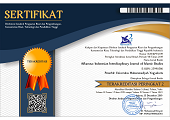Da'wa in Social Media: The Views of Ustad Hanan Attaki and Felix Siauw to The Hijrah Phenomenon
Abstract
This article examines the views of Ustad Hanan Attaki (UHA) and Ustad Felix Siauw, who use social media as a medium of preaching. The utilization of the internet as a new way of preaching Islam has helped shape contemporary forms of religious thinking and behavior for Muslim youth in Indonesia. One of them is marked by the emergence of the trend of hijrah in their community. This study aimed to explain the Islamic views of UHA and Siauw, which have implications for the emergence and development of the hijrah trend. This research focuses on extracting data through observations on a number of predetermined social media accounts, field participation and interviews, and puts forward literature studies on the fragmentation of religious authority as a result of the emergence of a number of popular ustadz who use social media as a new space for preaching. Regarding the fragmentation of religious authority, this article is based on the thesis of Eickelman and Anderson, which states that the current religious authorities are those who have succeeded in transmitting religious texts and preaching them through new media. In more detail, this study discusses two important issues, namely the trend of Islamic da'wa on social media and, in particular, the implications of the Islamic views of UHA and Siauw for the emergence of the trend of hijrah Muslim youth. This article concludes that according to UHA, hijrah is a message of Islamic da'wa that not only tells about individual repentance but also as a current trend that young Muslims must follow. Meanwhile, Siauw interprets it as an effort to awaken the spirit of Muslims to achieve the establishment of the Islamic Khilafah.
Keywords
Full Text:
PDFReferences
Abdul Karim Amrullah. (1982). Tafsir Al-Azhar Juz XIX-XX.
Akmaliyah, W. (2020). The Rise of Cool Ustadz: Preaching, Subcultures, and the Pemuda Hijrah Movement. In The New Santri: Challanges to Traditional Religious Authority in Indonesia (pp. 239–257).
Al-Bugha, M. D. (2013). Al Fiqhu Al Manhaji ’ala Madzhabil Imam Asy Syafi’i. Darul Musthafa Damaskus.
Burhani, A. N. (2020). Muslim Televangelists in the Making: Conversion Narratives and the Construction of Religious Authority. The Muslim World, 110(2), 154–175.
Burhanudin, J. (2007). Islamic Knowledge, Authority and Political Power: the Ulama in Colonial Indonesia. Unpublished Doctoral Thesis. Leiden: Universiteit Leiden.
Campbell, H. A. (2012). Digital religion: Understanding religious practice in new media worlds. Routledge.
Dewi, O. S. (n.d.). Pengajian selebritas hijrah kelas menengah muslim (2000-2019): respons atas dakwah Salafi dan Jamaah Tabligh.
Eickelman, D. F., & Anderson, J. W. (1997). Print, Islam, and the prospects for civic pluralism: new religious writings and their audiences. Journal of Islamic Studies, 8(1), 43–62.
Han, M. I. (2018). Anak Muda, Dakwah Jalanan Dan Fragmentasi Otoritas Keagamaan: Studi Atas Gerakan Dakwah Pemuda Hijrah dan Pemuda Hidayah. UIN Sunan Kalijaga.
Hasan, N. (2018). Literatur Keislaman Generasi Milenial: Transmisi, Apropriasi, dan Kontestasi. Pascasarjana UIN Sunan Kalijaga Press.
Hew, W. W. (2018). THE ART OF DAKWAH: social media, visual persuasion and the Islamist propagation of Felix Siauw. Indonesia and the Malay World, 46(134), 61–79.
Hoesterey, J. B. (2015). Rebranding Islam: Piety, prosperity, and a self-help guru. Stanford University Press.
Kailani, N. (2011). Kepanikan Moral dan Dakwah Islam Populer (Membaca Fenomena ‘Rohis’ di Indonesia). Analisis: Jurnal Studi Keislaman, 11(1), 1–16.
Kailani, N. (2012). Forum Lingkar Pena and Muslim Youth in Contemporary Indonesia. RIMA: Review of Indonesian and Malaysian Affairs, 46(1), 33.
Kailani, N. (2018). Preachers-cum-Trainers: The Promoters of Market Islam in Urban Indonesia. Islam in Southeast Asia: Negotiating Modernity, 164–191.
Kaptein, N. J. G. (2018). Fatwa in Indonesia: An Analysis of Dominant Legal Ideas and Modes of Thought of Fatwa-Making Agencies and Their Implications in the Post-New Order Period, by Pradana Boy Zulian. Bijdragen Tot de Taal-, Land-En Volkenkunde/Journal of the Humanities and Social Sciences of Southeast Asia, 174(4), 549–551.
Müller, D. M. (2014). Islam, politics and youth in Malaysia: the pop-Islamist reinvention of PAS. Routledge.
Muthohirin, Nafik. (2014). Fundamentalisme Islam: Gerakan dan Tipologi Pemikiran Aktivis Dakwah Kampus. IndoStrategi.
Nisa, Y. F., Hendarmin, L. A., Lubis, D. A., Syafruddin, D., & Ropi, I. (2018). Gen Z: Kegalauan Identitas Keagamaan. Pusat Pengkajian Islam Dan Masyarakat (PPIM), UIN Jakarta.
Internet, Pemerintah, dan Pembentukan Sikap Keberagamaan Generasi Z, (2018). https://ppim.uinjkt.ac.id/2018/11/11/survey-ppim-internet-pemerintah-dan-pembentukan-sikap-keberagamaan-generasi-z/
Saat, N., & Burhani, A. N. (2020). The New Santri: Challenges to Traditional Religious Authority in Indonesia. ISEASтАУYusof Ishak Institute.
Schäfer, S. (2019). Democratic Decline in Indonesia: The Role of Religious Authorities. Pacific Affairs, 92(2), 235–255.
Siauw, F. (2014). Khilafah Remake. Al Fatih Press.
Siauw, F. Y. (2013). Yuk, berhijab! Penerbit Mizania.
Siauw, F. Y. (2015). Udah putusin aja! Alfatih Press.
Slama, M. (2017). A subtle economy of time: Social media and the transformation of Indonesia’s Islamic preacher economy. Economic Anthropology, 4(1), 94–106.
Ummah, S. N. (2019). Makna hijrah perspektif Hamka dalam tafsir Al Azhar dan konteksualisasinya dalam kehidupan sosial di Indonesia. UIN Sunan Ampel Surabaya.
We Are Social. (2020). Hootsuite (We are Social): Indonesian Digital Report 2020. In Global Digital Insights.
Weber, M. (1947). The Theory of Social and Economic Organization, terj. AM Henderson and Ta [Cott Parsons (New York: Free Press, 1947).
Yuswohady. (2014). Marketing to the Middle Class Moslem: Kenali Perubahannya, Pahami Perilakunya, Petakan Strateginya. Gramedia.
Zulkifli, Z. (2013). The Ulama in Indonesia: Between Religious Authority and Symbolic Power. MIQOT: Jurnal Ilmu-Ilmu Keislaman, 37 (1).
DOI: https://doi.org/10.18196/afkaruna.v17i2.12671
Refbacks
- There are currently no refbacks.
Copyright (c) 2021 Afkaruna: Indonesian Interdisciplinary Journal of Islamic Studies

This work is licensed under a Creative Commons Attribution-ShareAlike 4.0 International License.
Afkaruna: Indonesian Interdiciplinary Journal of Islamic Studies indexed by:












1.png)


